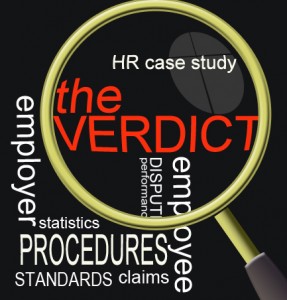 People don’t choose things, they choose expected results. Case studies show how things are done in practice. Ideally presented, case studies tell the exacting story of a specific human resources challenge. Here is an example of a situation dealing with performance standards.
People don’t choose things, they choose expected results. Case studies show how things are done in practice. Ideally presented, case studies tell the exacting story of a specific human resources challenge. Here is an example of a situation dealing with performance standards.
Smith v. Allstate Insurance Company, Case No. 05-3969
Deborah Smith, a 47-year old African American woman, was fired from Allstate Insurance in 2003 following 29 years with the company for failing to meet company performance standards. A claims adjuster for her last 23 years with the company, Smith was required to investigate, assess, and resolve property damage claims. It is documented that in early-2002 she received an average of 140 claims per month and that Allstate hired more claims adjusters at that time, which ultimately reduced her average to 100 claims per month.
To meet company performance standards, each Allstate claims adjuster had to undergo an annual evaluation of skills—i.e. “timely claims investigation and customer contact, customer service, and proper file documentation”—in addition to two “checkpoint” reviews (in June and October) over the course of the year. These skill areas were then calculated into an overall performance rating. Any score below 70 received a “requires improvement” rating and the employee was placed on a 60-day corrective review plan. Smith scored a 49.4, a score which was consistent with her 2002 checkpoint scores of 38.7 and 40.4, and after the 60-day review plan she was granted 120 more days—in 30-, 60-, and 30-day increments—to meet the company performance goals. Instead of improving, Smith’s overall performance dropped to 43.9.
Smith’s performance was not the only thing that dropped that year. Allstate’s need for claims specialists also dropped, as auto and property counts decreased and were expected to dwindle. Due to this drop, Allstate found it necessary to reduce the number of employees working in the claims department, and devised criteria (business need, performance rating, and employee’s service date) to determine which employees would be affected. A total of 32 were let go, Smith among them.
Smith charged Allstate with gender and race discrimination in violation of Title VII and the Civil Rights Act of 1964; age discrimination in violation of the Age Discrimination in Employment Act; and retaliatory discharge in violation of Title VII and the Fair Labor Standards Act. Even though Smith claimed her termination was discriminatory based on her age, sex, and race, she overlooked that 14 of the 32 terminated were under the age of 40, 17 of those terminated were male, and 11 of those terminated were minorities. In addition to this oversight, Smith was not qualified for the position, as represented by her poor performance rating, and she failed to present how her dismissal was retaliatory or vengeful. Unsuccessful with her prior charges, Smith went on to challenge Allstate’s evaluation system, asserting that not enough of her work was reviewed to accurately determine her performance rating. Smith’s challenge, however, neglected to consider that all employees were subjected to this evaluation system, and she presented no evidence that this evaluation system was discriminatory.
Court ruling: Smith failed to illustrate that she received unequal treatment from Allstate, and failed to show that Allstate terminated her for any reason other than her poor performance. The court ruled in favor of Allstate.
HR Advocate does not give legal advice, but provides best practices advice to help employers reduce risk of liability and improve communications and relationships with employees. Do you see your company experiencing a similar case?
Case study written by Jennifer Lozier – HR Advocate contributor
